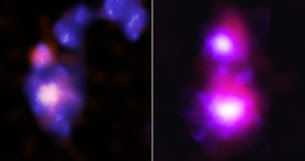X-ray Pioneers : Chandra Observatory’s Odyssey through the Celestial Depths
- Aagam sanghavi
- Jan 30, 2024
- 2 min read

Unraveling the Cosmic Tapestry: Chandra X-ray Observatory’s Saga
In the grand cosmic theater, where the universe dons its most enigmatic costumes, the Chandra X-ray Observatory stands as humanity’s eye into the unseen realms. Launched by NASA in 1999, Chandra has been an unrivaled pioneer, deciphering the universe’s secrets encoded in X-ray frequencies. In this comprehensive exploration, we embark on a captivating journey, unveiling the multifaceted story of Chandra – its functions, motives, structure, historic milestones, and the mesmerizing discoveries that have reshaped our understanding of the cosmos.
X-ray Vision: Chandra’s Functions and Motive
Unveiling Cosmic Hotspots
Chandra’s primary function is to observe high-energy X-rays emanating from celestial objects. By capturing these elusive rays, it unveils the hottest, most dynamic regions of the universe, revealing details invisible to other telescopes.
Decoding Stellar Life Cycles
From supernova remnants to pulsars and black holes, Chandra plays a crucial role in decoding the life cycles of stellar objects. It’s a cosmic detective, providing insights into the birth, evolution, and demise of stars.
Probing Galactic Nuclei
Chandra’s gaze extends to the hearts of galaxies, where supermassive black holes reside. By studying the radiation emitted from these active galactic nuclei, scientists gain essential clues about the cosmic processes at play.
Charting the Cosmic Web
Chandra contributes to mapping the large-scale structure of the universe, uncovering the vast cosmic web formed by the distribution of hot gas between galaxies.
Engineering Marvel: The Structure of Chandra X-ray Observatory
Mirrors of Precision
Chandra’s mirrors are coated with a thin layer of iridium, a choice that enhances reflectivity in the X-ray range. Nested mirrors, rather than traditional lenses, focus the incoming X-rays onto detectors with exceptional precision.
Space-Resilient Design
Crafted to endure the rigors of space, Chandra orbits Earth in an elliptical trajectory, minimizing interference from the planet’s radiation belts. This resilient design ensures the telescope’s longevity and sustained scientific contributions.
Chronicles of Chandra: A Historic Journey
Launch into the Unknown
Chandra embarked on its cosmic odyssey aboard the Space Shuttle Columbia on July 23, 1999. Named after the astrophysicist Subrahmanyan Chandrasekhar, the telescope began its mission to unravel the mysteries of the X-ray universe.
Milestones and Legacy
Throughout its journey, Chandra has left an indelible mark on astrophysics. From confirming the existence of dark energy to identifying numerous neutron stars, its discoveries have rewritten the cosmic narrative.
A Gallery of X-ray Marvels





Conclusion: Chandra’s Ongoing Odyssey
As we reflect on the cosmic voyage of the Chandra X-ray Observatory, we recognize its indispensable role in reshaping our cosmic comprehension. The observatory continues to unravel the X-ray mysteries, painting a vivid portrait of the universe’s hidden intricacies. “X-ray Pioneers” pays homage to the brilliance of Chandra – a beacon illuminating the celestial darkness, guiding us into the depths of the cosmos where new revelations await discovery.




Comments